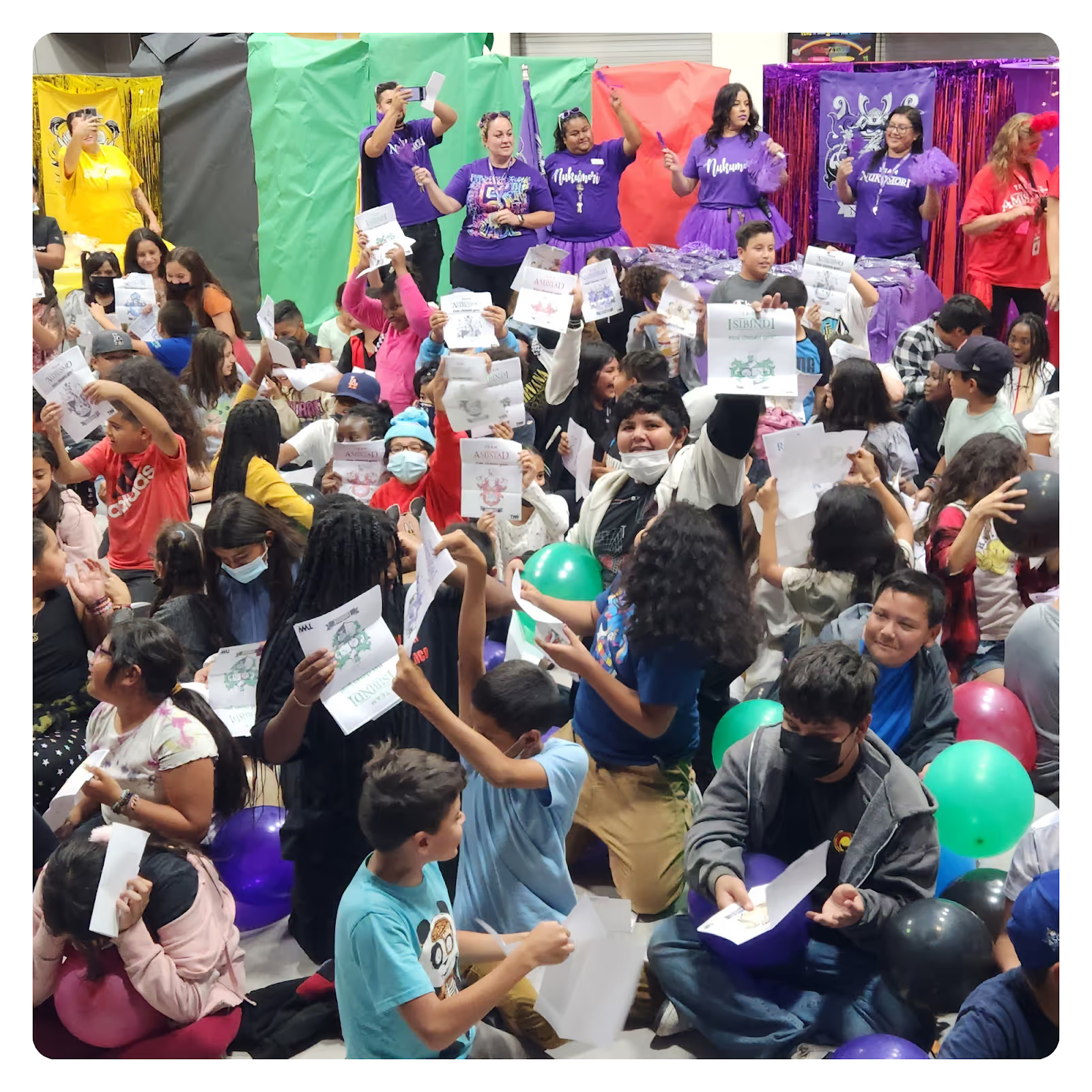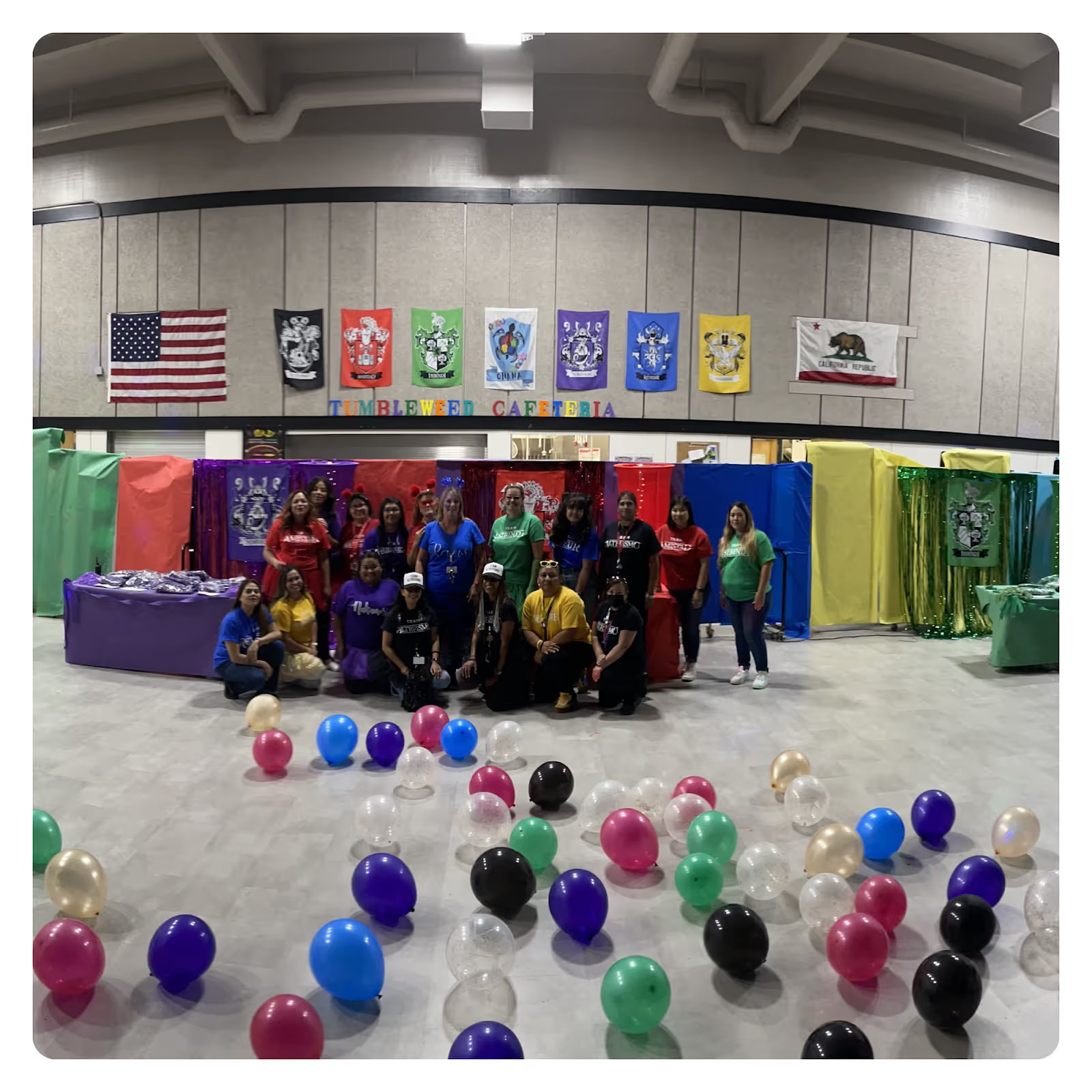
Tumbleweed Elementary improved student behavior and engagement by transforming its culture with a House System.


Track inventory in your school and classroom rewards stores, offer Amazon-style shopping to students, and more!
Launch a school-wide behavior and rewards system that's motivational for students and easy for teachers.
Create camaraderie and friendly competition with a school-wide House Points system. Join an interactive demo to learn more!

Track behavior, motivate students, and promote a positive culture – all in one easy platform.


Tumbleweed Elementary, nestled in the Palmdale School District of California, was struggling.
Recognized as an underperforming school, Tumbleweed faced significant challenges that disrupted both teaching and learning. Behavioral issues created a chaotic and unmanageable environment.
“We had a lot of work to do with culture; student discipline was out of control in the beginning,” said Misti Larrick, Principal of Tumbleweed Elementary. This contributed to a negative school culture, making it difficult for students to thrive and for teachers to stay motivated.
The need for a transformation was urgent. But before we dive into solutions, let’s go a bit deeper into the problem.
Lorem ipsum dolor sit amet, consectetur adipiscing elit, sed do eiusmod tempor incididunt ut labore et dolore magna aliqua. Ut enim ad minim veniam, quis nostrud exercitation ullamco laboris nisi ut aliquip ex ea commodo consequat. Duis aute irure dolor in reprehenderit in voluptate velit esse cillum dolore eu fugiat nulla pariatur.
Block quote
Ordered list
Unordered list
Bold text
Emphasis
Superscript
Subscript

Track inventory in your school and classroom rewards stores, offer Amazon-style shopping to students, and more!
Launch a school-wide behavior and rewards system that's motivational for students and easy for teachers.
Create camaraderie and friendly competition with a school-wide House Points system. Join an interactive demo to learn more!

Track behavior, motivate students, and promote a positive culture – all in one easy platform.


Tumbleweed Elementary, nestled in the Palmdale School District of California, was struggling.
Recognized as an underperforming school, Tumbleweed faced significant challenges that disrupted both teaching and learning. Behavioral issues created a chaotic and unmanageable environment.
“We had a lot of work to do with culture; student discipline was out of control in the beginning,” said Misti Larrick, Principal of Tumbleweed Elementary. This contributed to a negative school culture, making it difficult for students to thrive and for teachers to stay motivated.
The need for a transformation was urgent. But before we dive into solutions, let’s go a bit deeper into the problem.
It was more exciting than Christmas morning!
At Tumbleweed, the school culture was in shambles. Student discipline played a far too large role, leading to constant disruptions and an environment where learning was nearly impossible.
Parents were frustrated and angry, voicing their concerns about the school’s inability to manage these issues. Meanwhile, the staff struggled with low morale and a sense of helplessness, as they faced daily challenges without effective support.
With tensions high among all stakeholders, it was clear that a major overhaul was needed. The logical first step was to reset the culture.
Addressing the core issues of discipline and creating a positive school environment became the top priority. Without this foundational change, any efforts to improve academic performance or staff satisfaction would be in vain.
In the beginning, Tumbleweed embraced the Capturing Kids' Hearts (CKH) philosophy to rebuild its culture. CKH is based on the belief that if you have a child's heart, you have their mind, with relationships coming first in all aspects. Fully committed to this approach, Tumbleweed earned recognition as a CKH National Showcase School within two years and has proudly held this title for six consecutive years.
Turning around Tumbleweed Elementary began with a bold idea: a House System designed to rebuild school culture and re-engage the community. Inspired by Hamish Brewer's book, Relentless, Principal Misti Larrick and her team introduced this system to enrich their positive culture, adding a layer that exponentially increased the sense of belonging and connectedness among students and staff.
A House System is a structured approach used in schools to foster a sense of community, encourage positive behavior, and promote student engagement. Each student is assigned to a "House," which is a small, supportive group within the larger school community.
The House System often includes:
House Identity: Each House has its own name, logo, and colors, creating a sense of belonging and identity.
Point System: Students earn points for positive behavior, academic achievements, and participation in school activities. Points contribute to their House's overall score.
Competitions and Events: Houses compete in various activities and events, such as sports, academic challenges, and creative contests. This promotes teamwork and school spirit.
Rewards and Recognition: Houses are recognized and rewarded for their achievements, fostering a motivating and encouraging environment.
The House System aims to create a positive school culture by making students feel connected and valued, encouraging them to support one another, and driving collective success.
This led them to the Ron Clark Academy, a place renowned for its vibrant school culture and focus on Houses. The visit, along with advice from Melissa Lime of Freedom Crossing Academy, introduced them to LiveSchool’s House Points system—who had used the system to turn a campus of 2,000 students into a collaborative community in St. Johns County, Florida.
The rollout of the House System was a carefully crafted spectacle. It began with a compelling message: “Something big is coming,” displayed in the school office. This sparked curiosity and excitement among the staff and students.
Over the next few weeks, House logos and colors started appearing around the building, creating a sense of anticipation. The grand unveiling was a hit. The cafeteria buzzed with energy during the House Selection event, where students eagerly discovered which House they’d join.

To cap off the excitement, Principal Larrick and her team organized a series of reward events and House Competitions. This included a flag football tournament around Super Bowl Sunday, bringing students and staff together for some friendly competition.
They also held minute-to-win-it challenges, Easter egg hunts, and crowned a House Champion, making sure the new system was fun and inclusive.
“It was more exciting than Christmas morning!” Larrick said, reflecting the joy and enthusiasm that swept through Tumbleweed Elementary. The House System had transformed the school, creating a positive and cohesive environment where everyone felt involved and motivated.
The implementation of the House System at Tumbleweed Elementary brought notable improvements in school discipline, reflecting its positive impact. Despite an increase in student enrollment, the suspension rates remained steady across the years.
From 2021 to 2022, the suspension rate was 0.06%, a figure that stayed consistent through 2023-2024, even as enrollment numbers fluctuated.
Attendance also saw a commendable rise. The annual average increased from 88% in 2021-2022 to 91% in 2023-2024, signaling greater student engagement and satisfaction.
Office referrals highlighted significant progress. Major referrals, primarily fights, dropped from 77 in 2021-2022 to 34 in 2023-2024.
The House System’s focus on building a positive culture and fostering community clearly contributed to these improvements, creating a more stable and supportive environment for both students and staff.

The key to a successful school transformation is buy-in from all stakeholders. Identify what motivates each group: students thrive on points and rewards, parents seek happy kids and involvement opportunities, and teachers want fewer disruptions and higher engagement.
At Tumbleweed Elementary, involving these stakeholders was crucial. Students embraced the House System’s rewards, parents enjoyed participating in school events, and teachers benefited from a more positive and manageable classroom environment.
Intentional implementation of the House System was critical to its success. It’s not just about rolling out a new program but about embedding it into the school culture thoughtfully.
This means clear communication, consistent application of the system, and ongoing engagement with all stakeholders. By being deliberate in how the system is introduced and maintained, schools can ensure it becomes an integral part of the daily routine, rather than just another initiative.
LiveSchool can facilitate this transformation if you’re intentional and engage your community effectively.

Track inventory in your school and classroom rewards stores, offer Amazon-style shopping to students, and more!
Launch a school-wide behavior and rewards system that's motivational for students and easy for teachers.
Create camaraderie and friendly competition with a school-wide House Points system. Join an interactive demo to learn more!

Track behavior, motivate students, and promote a positive culture – all in one easy platform.


Tumbleweed Elementary, nestled in the Palmdale School District of California, was struggling.
Recognized as an underperforming school, Tumbleweed faced significant challenges that disrupted both teaching and learning. Behavioral issues created a chaotic and unmanageable environment.
“We had a lot of work to do with culture; student discipline was out of control in the beginning,” said Misti Larrick, Principal of Tumbleweed Elementary. This contributed to a negative school culture, making it difficult for students to thrive and for teachers to stay motivated.
The need for a transformation was urgent. But before we dive into solutions, let’s go a bit deeper into the problem.
Tumbleweed Elementary, nestled in the Palmdale School District of California, was struggling.
Recognized as an underperforming school, Tumbleweed faced significant challenges that disrupted both teaching and learning. Behavioral issues created a chaotic and unmanageable environment.
“We had a lot of work to do with culture; student discipline was out of control in the beginning,” said Misti Larrick, Principal of Tumbleweed Elementary. This contributed to a negative school culture, making it difficult for students to thrive and for teachers to stay motivated.
The need for a transformation was urgent. But before we dive into solutions, let’s go a bit deeper into the problem.
You know what they teamwork makes the dream work. These articles have been written by the wonderful members of our team.

Track inventory in your school and classroom rewards stores, offer Amazon-style shopping to students, and more!
Launch a school-wide behavior and rewards system that's motivational for students and easy for teachers.
Create camaraderie and friendly competition with a school-wide House Points system. Join an interactive demo to learn more!

Track behavior, motivate students, and promote a positive culture – all in one easy platform.


Tumbleweed Elementary, nestled in the Palmdale School District of California, was struggling.
Recognized as an underperforming school, Tumbleweed faced significant challenges that disrupted both teaching and learning. Behavioral issues created a chaotic and unmanageable environment.
“We had a lot of work to do with culture; student discipline was out of control in the beginning,” said Misti Larrick, Principal of Tumbleweed Elementary. This contributed to a negative school culture, making it difficult for students to thrive and for teachers to stay motivated.
The need for a transformation was urgent. But before we dive into solutions, let’s go a bit deeper into the problem.

Track inventory in your school and classroom rewards stores, offer Amazon-style shopping to students, and more!
Launch a school-wide behavior and rewards system that's motivational for students and easy for teachers.
Create camaraderie and friendly competition with a school-wide House Points system. Join an interactive demo to learn more!

Track behavior, motivate students, and promote a positive culture – all in one easy platform.


Tumbleweed Elementary, nestled in the Palmdale School District of California, was struggling.
Recognized as an underperforming school, Tumbleweed faced significant challenges that disrupted both teaching and learning. Behavioral issues created a chaotic and unmanageable environment.
“We had a lot of work to do with culture; student discipline was out of control in the beginning,” said Misti Larrick, Principal of Tumbleweed Elementary. This contributed to a negative school culture, making it difficult for students to thrive and for teachers to stay motivated.
The need for a transformation was urgent. But before we dive into solutions, let’s go a bit deeper into the problem.